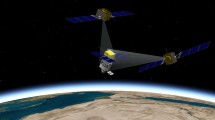Abstract
The celestial navigation using the difference between the direct and reflected solar light is emerging, as the difference can remove the conjoint bias caused by the instability and unpredictability of sunlight. These navigation methods include the solar Doppler difference and the solar TDOA (time difference of arrival). The solar TDOA measurement has a high positioning accuracy. However, the solar flare is unpredictable, which leads to the instability and randomness of the positioning performance in the approach phase. Fortunately, the solar Doppler difference navigation is stable. However, this navigation system is unobservable. To utilize their advantages and avoid their disadvantages, we combine them and propose the solar TDOA/Doppler difference joint observation. Due to its unobservability, we integrate it with the Mars angle navigation, and develop the solar light joint observation/Mars angle integrated navigation that is completely observable. The simulation results demonstrate the stability and robustness of the solar TDOA/Doppler difference joint observation navigation method. Compared with the celestial navigation using one solar difference observation such as the TDOA or the Doppler, the solar light joint observation/Mars angle integrated navigation can provide higher and more stable navigation accuracy.








Similar content being viewed by others
References
Ning XL, Fang JC (2007) An autonomous celestial navigation method for LEO satellite based on unscented Kalman filter and information fusion. Aerosp Sci Technol 11(2):222–228
Cui P, Wang S, Gao A et al (2016) X-ray pulsars/Doppler integrated navigation for Mars final approach. Adv Space Res 57(9):1889–1900
Rayman MD, Varghese P, Lehman DH et al (2000) Results from the Deep Space 1 technology validation mission. Acta Astronaut 47(2):475–487
Fang BD, Wu MP, Zhang W (2015) Mars gravity capture dynamic model and error analysis. Chin J Theor Appl Mech 47(1):15–23
Liever P, Habchi S, Burnell S, Lingard JS (2003) Computational fluid dynamics prediction of the Beagle 2 aerodynamic database. J Spacecr Rocket 40(5):632–638
Liechty D (2007) Aeroheating analysis for the Mars reconnaissance orbiter with comparison to flight data. J Spacecr Rocket 44(6):1226–1231
Ning XL, Wang LH, Bai XB et al (2013) Autonomous satellite navigation using starlight refraction angle measurements. Adv Space Res 51(9):1761–1772
Long AC, Leung D, Folta D, Gramling C (2000) Autonomous navigation of high-earth satellites using celestial objects and Doppler measurements. In: AIAA/AAS astrodynamics specialist conf., Denver, pp 1–9
Liu J, Wu J, Xiong L, Fang JC, Liu G (2017) Fast position and velocity determination for pulsar navigation using NML and LSM. Chin J Electron 26(6):1325–1329
Ning XL, Li Z, Wu WR et al (2017) Recursive adaptive filter using current innovation for celestial navigation during the Mars approach phase. Sci China Inf Sci 60(3):032205
Zhang W, Chen X, You W, Zhang W, Fang BD (2013) New autonomous navigation method based on redshift. Aerosp Shanghai 30(2):32–38
Yang CW, Deng XP (2012) Integrated navigation based on pulsars and sun observation including clock error correction. J Beijing Univ Aeronaut Astronaut 38(11):1469–1473
Joseph NP, Firooz A (2015) Handbook of cosmic hazards and planetary defense. Springer, Cham
Hamidi ZS, Shariff NNM (2014) Chronology of formation of solar radio burst types III and V associated with solar flare phenomenon on 19th September 2011. Int Lett Chem Phys Astron 5:32–42
Liu J, Fang JC, Yang ZH, Kang ZW, Wu J (2015) X-ray pulsar/Doppler difference integrated navigation for deep space exploration with unstable solar spectrum. Aerosp Sci Technol 41(1):144–150
Liu J, Fang JC, Liu G, Wu J (2017) Solar flare TDOA navigation method using direct and reflected light for Mars exploration. IEEE Trans Aerosp Electron Syst 53(5):2469–2484
Ning XL, Gui MZ, Fang JC et al (2018) A novel autonomous celestial navigation method using solar oscillation time delay measurement. IEEE Trans Aerosp Electron Syst 54(3):1392–1403
Liu J, Ning XL, Ma X, Fang JC (2019) Geometry error analysis in solar Doppler difference navigation for the capture phase. IEEE Trans Aerosp Electron Syst 55(5):2556–2567
Dan S (2006) Optimal state estimation: Kalman, H∞, and nonlinear approaches. Wiley, New York
Bucy RS, Renne KD (1971) Digital synthesis of nonlinear filter. Automatica 7(3):287–289
Sunahara Y (1970) An approximate method of state estimation for nonlinear dynamical systems. Trans ASME Ser D J Basic Eng 92(2):385–393
Yim JR, Crassidis JL, Junkins JL (2000) Autonomous orbit navigation of interplanetary spacecraft. In: The AIAA/AAS astrodyn. spec. conf., Denver
Acknowledgements
This work was supported by the National Natural Science Foundation of China (No. 61873196, No. 61501336, No. 61772187), and the National Basic Research Program of China (No. 2014CB744202).
Author information
Authors and Affiliations
Corresponding author
Additional information
Publisher's Note
Springer Nature remains neutral with regard to jurisdictional claims in published maps and institutional affiliations.
Rights and permissions
About this article
Cite this article
Pan, C., Liu, J., Kang, Zw. et al. Solar TDOA/Doppler Difference Joint Observation Navigation for the Approach Phase of Mars Exploration. Int. J. Aeronaut. Space Sci. 21, 836–844 (2020). https://doi.org/10.1007/s42405-020-00253-y
Received:
Revised:
Accepted:
Published:
Issue Date:
DOI: https://doi.org/10.1007/s42405-020-00253-y




